Cary Joji Fukunaga’s Beasts of No Nation (2015):
Criterion Blu-ray review
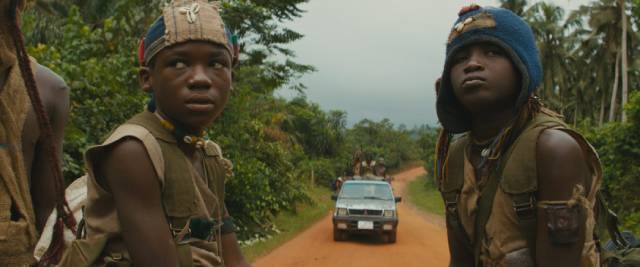
in Cary Joji Fukunaga’s Beasts of No Nation (2015)
A movie about child soldiers must inevitably be disturbing. Cary Joji Fukunaga’s Beasts of No Nation (2015) is definitely that, but perhaps not always in the ways he intended. Based on a 2005 novel by Uzodinma Iweala (who has a Nigerian background), which began as a thesis project at Harvard, it was shot on a relatively low budget on location in Ghana with a mostly non-professional cast. Location and cast provide an air of authenticity, but this is undercut to a degree by a decision to generalize the story – it takes place in an unnamed country torn by civil war, in which the factions are interchangeable, motives left undefined beyond the idea that pretty much all human beings are by nature corrupt and violent.
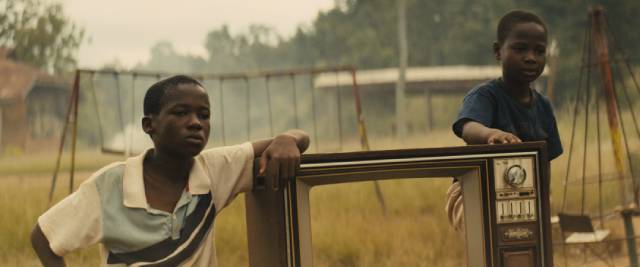
The narrative follows the experiences of a pre-adolescent boy named Agu (Abraham Attah) who lives in a small town in a buffer zone between fighting factions. Agu is mischievous and playful, but that play already suggests the influence of the conflict we hear fragments about over his father’s radio; he and his friends take the casing from the family television and try to sell it. Potential buyers complain that it has no tube, but Agu and his friends put on performances behind the set – soap operas, kung fu fights – it’s an imagination television, he says encouragingly. Life for these kids – at loose ends because, with the war washing over the country, there’s no longer any school – has an unreal quality which has taken on the forms of televised entertainment. Agu finally manages to trade the useless television to an amused soldier at a checkpoint for some food.
Fukunaga quickly establishes both the uncertainty of this time and place and the strength of the family within which Agu lives. Abruptly, the former overwhelms the latter. When news reports of a coup arrive, Agu’s mother and baby sister are evacuated to the capital, while he, his older brother, father and grandfather are trapped in the town. Soldiers of the new government arrive and immediately declare all those still in the town to be rebels, whom they proceed to execute. Agu is the only one who manages to escape, making his way into the country.
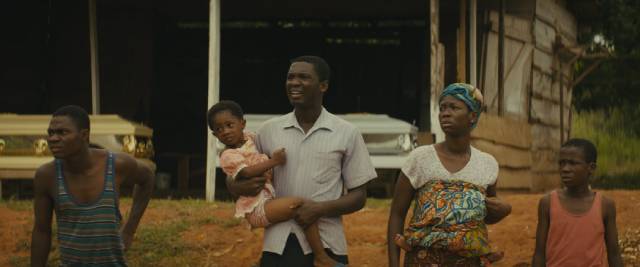
Fukunaga maintains Agu’s point of view, that of a child for whom these events are virtually incomprehensible. But as Agu makes his way through the bush, tired, hungry, traumatized and disoriented, Fukunaga imposes on his point of view with visual references aimed at an audience outside of Agu’s world. He’s suddenly surrounded by boys of his own age dressed in elaborate and colourful “camouflage” which immediately calls to mind Peter Pan’s Lost Boys (not to mention William Golding’s Lord of the Flies). Although based on the clothing worn by a faction in Sierra Leone, a western viewer is unlikely to make that real world connection. Taken prisoner by these boys, Agu now meets the story’s Captain Hook, a charismatic yet frightening soldier known only as the Commandant (Idris Elba). When his teen-aged second-in-command dismisses Agu as “just a boy”, the Commandant replies “A boy has hands to strangle and fingers to pull triggers. A boy is very, very dangerous.”
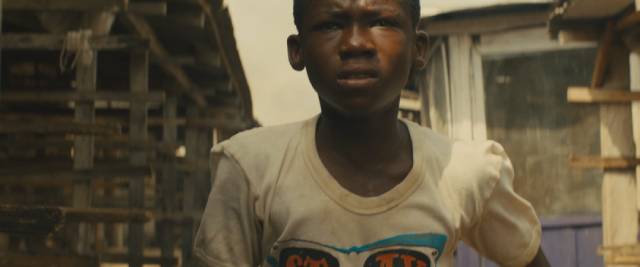
From here, the film follows Agu’s evolution from “just a boy” into a killer capable of committing terrible crimes. That process involves the gradual destruction of his identity and its replacement by a new one which is integrated into the Commandant’s battalion, a process which combines arbitrary punishment with a kind of affection proffered by the Commandant. This man uses his charisma to create a sense of belonging, a sense of purpose, although as the story progresses we see that his purpose is entirely self-serving, that every action he demands from his young army is designed to raise his own status in the revolutionary organization pushing back against the government established by the coup.
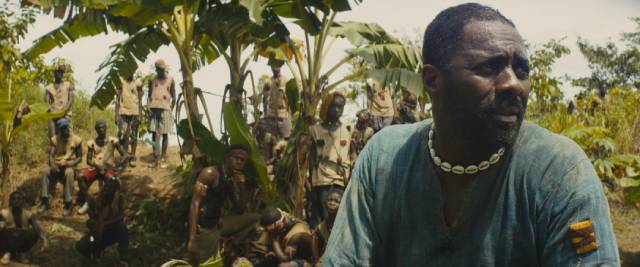
We occasionally get fragments of voice-over in which Agu reflects on his experiences – in this, we see that he is not just a helpless pawn, but rather is aware of what is happening and of his own part in events. After the harrowing scene in which the Commandant forces him to kill for the first time, Agu is shocked by what he has done, knows it’s wrong, but recognizes that it is what had to be done for his own survival. Having crossed that line, he becomes capable of killing with much less inner conflict. Like everyone else in the battalion, he has been transformed not into a revolutionary soldier fighting for a clearly defined cause, but rather into a criminal, a boy capable of committing war crimes.
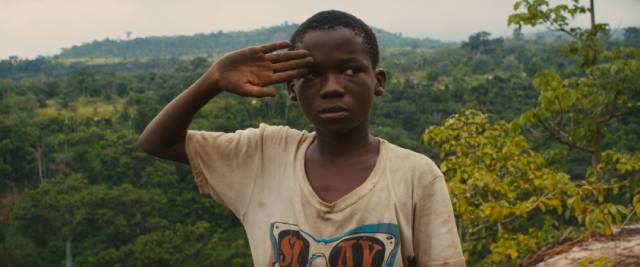
This new identity is inextricably bound up with the Commandant, a substitute father who fills an almost mythical position in Agu’s shattered life. The seemingly warm embrace offered by this man is revealed in all its toxic horror in an oblique scene (modeled perhaps on Lawrence’s encounter with the Turkish officer in David Lean’s Lawrence of Arabia [1962]?), which in retrospect explains the silence of Strika (Emmanuel Nii Adom Quaye), the closest thing to a friend Agu has in his new community. While this is obviously a very tricky thing to deal with in what is, despite its subject matter, a mainstream movie, it’s one of several instances in which Fukunaga displays a kind of coy restraint among the general horrors.
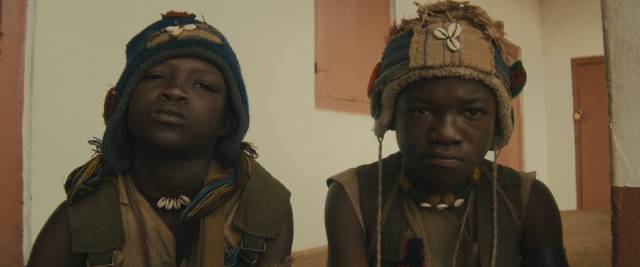
By holding back and requiring the audience to fill in the gaps, Fukunaga comes close to aestheticizing the horror of Agu’s experience. And yet I’m not sure how else he might have handled it. Despite the war setting, the film this most closely resembles (for me at least) is Héctor Babenco’s Pixote (1980), another story of a boy brutalized by a violent society which reshapes him in its own image – but Babenco never flinches, while Fukunaga ultimately seems to err on the side of “good taste”. One wonders how this same story might have been handled by an African filmmaker with more personal experience of the situations depicted.
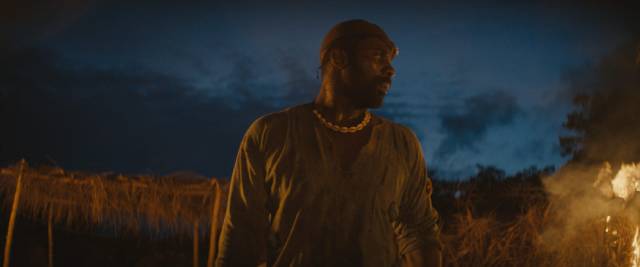
Towards the end, Agu gradually becomes aware of the Commandant’s limitations, belying the image he projects of a man who is all-powerful and thus has the legitimate authority to rewrite the boy’s identity. Rather than giving Agu something, a genuine replacement for his lost family and community, it becomes clear that he has merely been using these children to secure his own position in the new national order. The leader of the revolution has promised to make him a general, but instead, having secured his own position as the new president, he finds the Commandant to be an embarrassment, a war crime-committing thug.
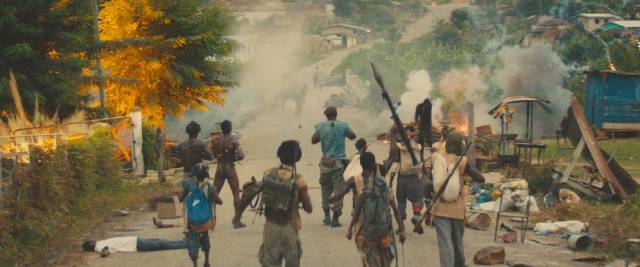
Here, the film comes closest to dealing with real politics, not just generalizations; the new president, Dada Goodblood (Jude Akuwudike), is more concerned with making deals with foreign governments and business interests than fulfilling his promise to a brutal thug like the Commandant, a promise made merely to get from the Commandant what was necessary as Dada consolidated his own power. The Commandant responds by taking his small private army back to the country where he now opposes the new regime, but he’s lost his authority and with it the hold he has on these child soldiers.
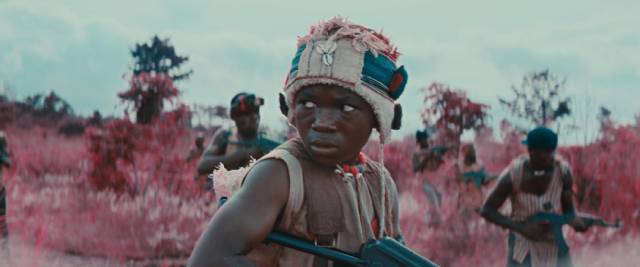
In a brief coda, as Agu is questioned by a supportive therapist, we can see that he has crossed a huge divide over which he can never return – he feels so much older and wiser than this well-meaning woman – and yet in its final images the film suggests that he can rejoin the world despite everything he has seen and done, that he can become a child again. This perhaps is the strongest indication that the film was made by outsiders, by people for whom what is depicted remains an alien experience which has been filtered somewhat through genre tropes rather than direct knowledge.
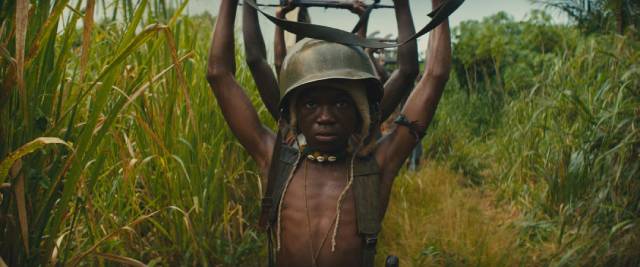
The tension between the material and its embodiment in the film is highlighted by the score by Dan Romer. Effective and atmospheric, it nonetheless reinforces that what we are seeing is a movie. It creates a mood but undermines the sense of realism at key moments, guiding the audience’s emotional response into more familiar channels rather than permitting a sense of revelation and discovery. As with Fukunaga’s visual strategies, the effect works against raw documentary realism and edges towards an aesthetic evocation of the violent horrors which overwhelm Agu’s life. This is amplified by erasure of a specific setting and specific political elements behind the conflict; while the intention was no doubt to make a general statement about the horrific effects of war, in effect it becomes a statement about the inherent violence of everybody who lives in this fictional African country.
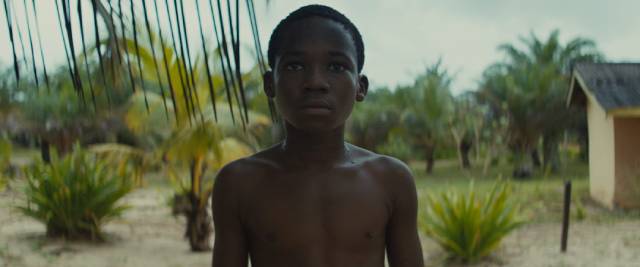
Fukunaga, who in addition to writing the script and directing also photographed the film, has formidable skills which include a great sensitivity both to performance, particularly with the non-professional children, and to the expressive possibilities of landscape (previously very much on display in his adaptation of Jane Eyre [2011] and the first season of True Detective [2014]). The contrast between the natural beauty of Ghana and the horrors perpetrated by the people who inhabit these spaces underlines the tension between Agu’s nature as a child and the acts he’s pushed into performing. This tension is given enormous dramatic power by Attah, who was about thirteen when he appeared in the film. While Elba is a dominating screen presence, radiating charm and menace until he begins to collapse into fear and failure, Attah holds the centre seemingly without effort. In the scene with the therapist near the end, he conveys everything he has experienced in an expression at once subtle and very deep; he can’t find words to convey to this woman what he has been through, but that look says it all in one brief moment.
*
The disk
Shot digitally, the film looks pristine on Criterion’s Blu-ray. Fukunaga had wanted to shoot in 35mm, but this was beyond the budget; to offset this limitation, he was able to use a set of original Panavision anamorphic lenses which give the 2.39:1 image a cinematic quality. Audio is clear, with subtle ambiances disrupted by abrupt bursts of gunfire. One somewhat distracting element is the shift, after the early use of subtitles over African dialogue, to everyone speaking to each other in fractured English, which detracts somewhat from the film’s attempt at authenticity.
The supplements
In a newly recorded commentary Fukunaga is joined by first assistant director Jon Mallard for a discussion which focuses on the many logistical difficulties of shooting in Ghana.
Three new featurettes cover aspects of the production and its context in Fukunaga’s career. Passion Project (1:01:41) recounts the production through behind-the-scenes footage and interviews with Fukunaga, author Iweala, actors Attah and Elba, and producers Amy Kaufman, Daniela Taplin Lundberg and Riva Marka.
A conversation between Fukunaga and cultural commentator Franklin Leonard (21:27) covers the origins and themes of the project and also addresses issues arising from an American filmmaker tackling the film’s subject.
Costume designer Jenny Eagan (20:09) discusses the various sources for the look of the costumes and the difficulties of working in Ghana.
There’s also a trailer (2:09) and a booklet essay by film critic Robert Daniels.
Comments